-
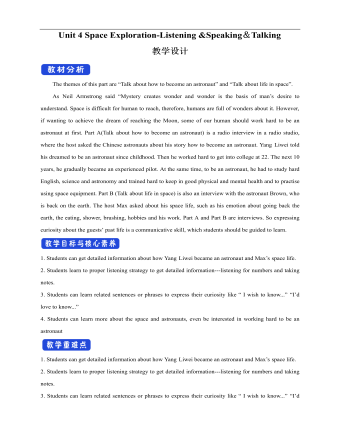
新人教版高中英语必修3Unit 4 Space Exploration-Listening&Speaking&Talking教学设计二
The themes of this part are “Talk about how to become an astronaut” and “Talk about life in space”. As Neil Armstrong said “Mystery creates wonder and wonder is the basis of man’s desire to understand. Space is difficult for human to reach, therefore, humans are full of wonders about it. However, if wanting to achieve the dream of reaching the Moon, some of our human should work hard to be an astronaut at first. Part A(Talk about how to become an astronaut) is a radio interview in a radio studio, where the host asked the Chinese astronauts about his story how to become an astronaut. Yang Liwei told his dreamed to be an astronaut since childhood. Then he worked hard to get into college at 22. The next 10 years, he gradually became an experienced pilot. At the same time, to be an astronaut, he had to study hard English, science and astronomy and trained hard to keep in good physical and mental health and to practise using space equipment. Part B (Talk about life in space) is also an interview with the astronaut Brown, who is back on the earth. The host Max asked about his space life, such as his emotion about going back the earth, the eating, shower, brushing, hobbies and his work. Part A and Part B are interviews. So expressing curiosity about the guests’ past life is a communicative skill, which students should be guided to learn.1. Students can get detailed information about how Yang Liwei became an astronaut and Max’s space life.2. Students learn to proper listening strategy to get detailed information---listening for numbers and taking notes.3. Students can learn related sentences or phrases to express their curiosity like “ I wish to know...” “I’d love to know...”4. Students can learn more about the space and astronauts, even be interested in working hard to be an astronaut
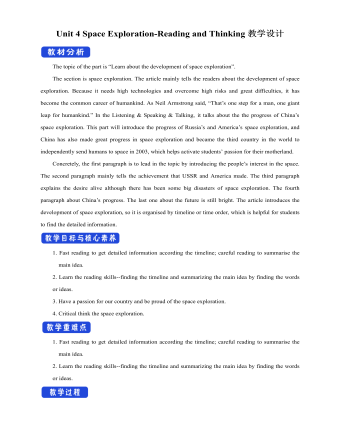
新人教版高中英语必修3Unit 4 Space Exploration-Reading and Thinking教学设计一
Q4: What is the function of the International exploration ?Having astronauts from different countries on boardQ5: What can you learn from Para 4 ?China has made great achievements in exploring spaceQ6: What is the attitude to the space exploration ?SupportiveStep 6 Post reading---RetellPeople have always wanted to learn more about space. Before the mid-20th century, most people felt (1)_________ (travel) into space was an impossible dream. However, (2)____ the help of scientists, peoplesucceeded in realizing their dream (3) _________ (explore) space. On 4 October 1957, the Sputnik 1 satellite (4) ____________(launch) by the USSR. (5) ________________ scientists try to make sure nothing goes wrong, accidents can still happen. These disasters made everyone(6)___________(disappoint), but people still believe in the importance of (7) ________(carry) on space exploration. In 2003, China became the third country to (8)_____________ (independent) send humans into space. Then Shenzhou 6 and 7 completed (9)____ second manned orbit and the first Chinese spacewalk. In spite of the difficulties, scientists hope future (10)__________ (discovery) will not only enable us to understand the universe but also help us survive well into the future.Answers: 1. travelling 2. with 3. to explore 4. was launched 5. Although6. disappointed 7. carrying 8. independently 9. a 10. discoveriesStep 6 Post reading---Critical thinkingQ1: What do you think of the space exploration ? I think it is beneficial to us. Through further study of space, people will make full use of it in the future, such as the space experiments by Wang Yaping in Tian Gong 1.Q2: If you are determined to be an astronaut, what should you prepare at present ?First of all, I should study hard to get a related college degree. Besides, I must keep mental and physical healthy.Step 7. HomeworkTry to summarize the structure of the article by a mind map.
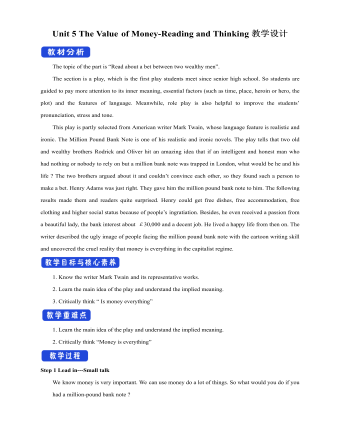
新人教版高中英语必修3Unit 5 The Value of Money-Reading and Thinking教学设计一
Everybody wants to get wealth.In today’s material world,making money or becoming wealthy symbolizes a person’s success and capability. Many people just make every effort, pay any price to attain greater wealth. With money,they can buy nice, large apartments in nice neighborhood. With money they can own luxurious cars. Wealth seems to bring all happiness in life.But is wealth the only road to happiness? Not really. There are many things in the world, which are beyond the means of money, such as friendship, love, health and knowledge. People are so preoccupied with struggling for money that they have no time or would not take the time to form or maintain friendship. What happiness can they feel living as lonely miserable creatures without love or friends in the world even if they accumulate tremendous wealth?In my opinion, people can’t do anything without money, but money is not everything. What money will bring you depends on your personal belief and goal in life. If you are kind enough to help others, especially the poor, money is a good thing to you. With it, you can do much more for the benefit of people and your country, and it will add to your own happiness. If you want money just for your own needs, you’ll never be satisfied or happy. In a word,you should have money spent for more people. Only then can money be the source of your happiness.Step 8 Homework4 students in a group, one acts Roderick, one Oliver, one servant and the fourth one acts Henry Adams, then listen to the tape, pay more attention to the difference between American English and British English in pronunciation, stress, tone.
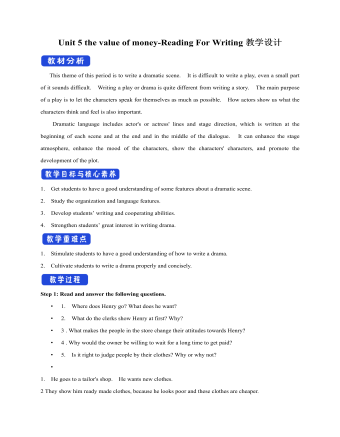
新人教版高中英语必修3Unit 5 the value of money-Reading For Writing教学设计一
【参考范文】Narrator:(Henry is smiling as he leaves the restaurant. As he is walking down the street, he sees a sign for a place that cuts hair. He decides to get it cut. )H=Henry;B=Barber;R=rude manH:Good afternoon, I'd like to get a cut, if I may. (The barber looks at Henry's hair and continues cutting another man's hair. )Er, I'd really like a haircut. As you can see it's much too long. B:(in a rude manner) Yes, I can see that. Indeed, I can. H:Fine, well I'll have a seat then. (He sits in one of the barber's chairs. The barber turns to look at Henry. )B:It's quite expensive here, you know!Are you sure you can afford it?H:Yes. I think so. (In comes the rude man. )R:Hey you there. I need a haircut quickly. Can you do me straightaway?B:All right, then, get in the chair and I'll see what I can do. R:Thank you. (sits down in one of the barber's chairs)H:Excuse me, but I was here first. Aren't you going to do my hair first?B:This man's in a hurry. H:Well so am I!I insist that you cut my hair first. B:OK, but I'll have to be quick. This gentleman is waiting. H:Thank you. (They both become quiet. After his hair is cut, the barber tells Henry how much he must pay. Henry shows the barber the bank note. )B:Why, Mr . . . (looks shocked)H:Adams. Henry Adams. I'm sorry, I don't have any change. R:You're that Mr Adams! Well,I'm glad I waited or I might never have known it was you. B:Why, Mr Adams, please don't worry!(wearing a big smile) Nothing to worry about!Nothing at all!Please come back any time, even if you only need too little hairs cut!It will be my honour to serve you!
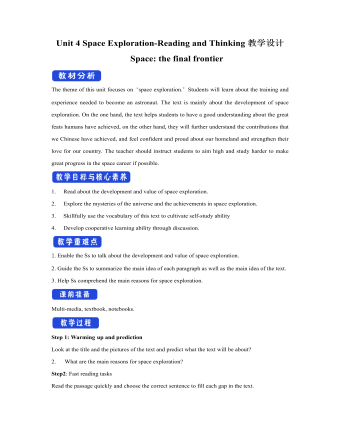
新人教版高中英语必修3Unit 4 Space Exploration-Reading and Thinking教学设计二
The theme of this unit focuses on “space exploration.” Students will learn about the training and experience needed to become an astronaut. The text is mainly about the development of space exploration. On the one hand, the text helps students to have a good understanding about the great feats humans have achieved, on the other hand, they will further understand the contributions that we Chinese have achieved, and feel confident and proud about our homeland and strengthen their love for our country. The teacher should instruct students to aim high and study harder to make great progress in the space career if possible.1. Read about the development and value of space exploration.2. Explore the mysteries of the universe and the achievements in space exploration.3. Skillfully use the vocabulary of this text to cultivate self-study ability 4. Develop cooperative learning ability through discussion.1. Enable the Ss to talk about the development and value of space exploration.2. Guide the Ss to summarize the main idea of each paragraph as well as the main idea of the text.3. Help Ss comprehend the main reasons for space exploration. Multi-media, textbook, notebooks.Step 1: Warming up and predictionLook at the title and the pictures of the text and predict what the text will be about?2. What are the main reasons for space exploration?
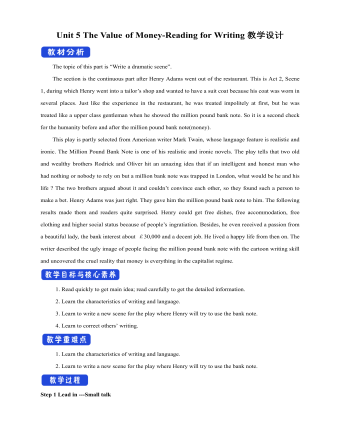
新人教版高中英语必修3Unit 5 The Value of Money-Reading for Writing教学设计二
2. 您能看到, 我头发太长了。You can see that my hair is much too long.3. 无论什么时候, 只要您想回来就回来。Please come back whenever you want.4. 您仅有很少的头发要理! You only have too little hair to cut !5. 为您服务是我的荣幸!It is my honour to serve you!Step 9 Writing(Henry is walking down the street when he sees a sign for a place that cuts hair. He decides to have it cut. )H=Henry B=BarberH: Good afternoon, I’d like to have my hair cut, if I may. (The barber looks at Henry’s hair and continues cutting another man’s hair. ) Er, I’d really like a haircut. As you can see it’s much too long. B: (in a rude manner) Yes, I can see that. Indeed, I can. H: Fine, well, I’ll have a seat then. (He sits in one of the barber’s chairs. The barber turns to look at Henry. )B: It’s quite expensive here, you know! Are you sure you can afford it?H: Yes. I think so. (After his hair is cut, the barber tells Henry how much he must pay. Henry shows the barber the bank note. )B: Why Mr. . . (looks shocked)H: Adams. Henry Adams. I’m sorry. I don’t have any change. B: Please don’t worry! (wearing a big smile) Nothing to worry about! Nothing at all! Please come back whenever you want, even if you only have too little hair to cut! It will be my honour to serve you!Step 10 Pair workExchange drafts with a partner. Use this checklist to help your partner revise his/her draft.1. Are all the elements of a play included and in good order ?2. Do the character use suitable language ?3. Are the stage directions clear and useful ?4. Is the plot clear and exciting enough ?

人教版高中地理必修2从市中心到郊区,你选择住哪里说课稿
课前活动:分成四组,对南京三个住房地段进行调查,新街口夫子庙、板仓、仙林,对住房居民进行问卷调查,自行设计调查问卷,分析该地段的房价要求,居民的要求,居民为何要在该地段购买住房,基础设施设置等等其它与居民购房有关的因素。◆设计意图:利用课前小组探究形式对所学问题进行相关调查,不仅让学生掌握知识了解知识来源于社会还能培养学生深入生活交际表达能力以及合作探究能力;3.问题设计同学们,不知道你们在调查过程中是否发现一个问题,郊区的房子,特别是别墅,都是些高档居所,许多有钱人的居住场所,那为什么会这样呢?伴随着城市化进程中居民都往城里挤,为什么还会有许多有钱人往郊区搬呢?这就是我们今天要研究的第二个问题:逆城市化。◆设计意图:承转过渡知识,从购房选择因素的学习过渡到郊区化的学习,同时培养学生发现问题的能力,给学生以启迪。
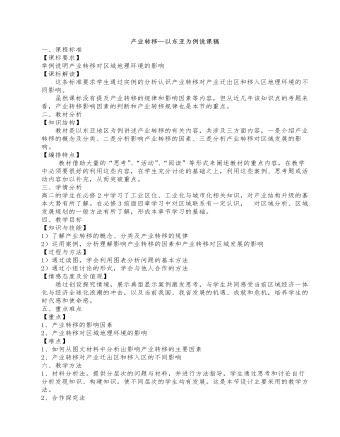
人教版高中地理必修3产业转移—以东亚为例说课稿
【情感态度及价值观】 通过创设探究情境,展示典型显示案例激发思考,与学生共同感受当前区域经济一体化与经济全球化浪潮的冲击,以及当前我国、我省发展的机遇、成就和危机,培养学生的时代感和使命感。五、重点难点【重点】1、产业转移的影响因素2、产业转移对区域地理环境的影响【难点】1、如何从图文材料中分析出影响产业转移的主要因素2、产业转移对产业迁出区和移入区的不同影响六、教学方法1、材料分析法。提供分层次的问题与材料,并进行方法指导,学生通过思考和讨论自行分析发现知识、构建知识。使不同层次的学生均有发展。这是本节设计主要采用的教学方法。2、合作探究法3、多媒体教学法七、 教学过程(一) 引入 :假如某同学买彩票中大奖,想投资生产面临几项选择1、投资高端智能手机制造还是普通服装厂?2、厂址选择在濮阳市还是南乐县?
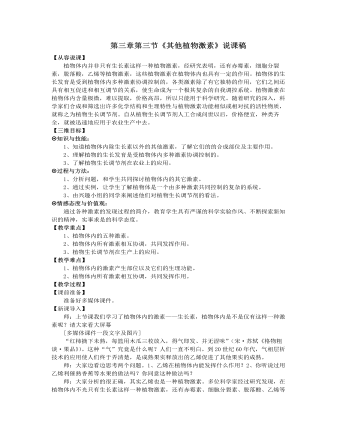
人教版高中生物必修3第三章第三节《其他植物激素》说课稿
二、应用生长调节剂的注意事项1、效果不稳定。2、使用时期。3、使用浓度和方法。4、使用生长调节剂仅是葡萄栽培管理的辅助手段,不能盲目孤立地依赖生长调节剂。生2:我们小组查的资料是关于小麦使用生长调节剂。小麦应用植物生长调节剂,可以调节植株的生长发育,具有控旺促壮、增强抗逆性、增加粒重、提高产量并有利于优质、早熟等多重效果。生3:我找了一篇生长调节剂对矮牵牛大型穴盘生产。师:上面三位同学利用课下的时间,在网上查的三段文字都相当的不错,大家可以从中学到一些书本上没有的知识,请大家结合刚刚三位同学的三段文字以及自己平时所积累的知识,讨论以下几个问题。师:你知道哪些农产品在生产过程中使用了植物生长调节剂?师:哪些水果在上市前有可能使用了乙烯利?师:生产过程中施用植物生长调节剂,会不会影响农产品的品质?师:如果你是水果销售员,面对半青不熟的水果,你认为应当使用乙烯利催熟吗?作为一个消费者,你又怎么看?
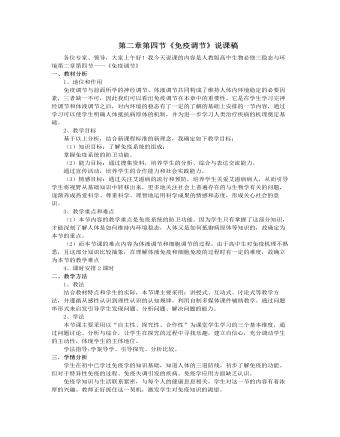
人教版高中生物必修3第二章第四节《免疫调节》说课稿
(四)、活动交流,体验科学通过资料分析讨论以下三个问题:1、你知道爱滋病的传播途径吗?2、如何预防爱滋病?3、我们应如何对待爱滋病患者?面对艾滋病我们能做些什么?从而进入情感态度的教育。除此之外,我还设计一个开放性的作业“向全社会为关注艾滋病设计一个宣传广告”(形式不限,漫画、板书、倡议书等),让学生把爱心付诸于实际行动。在此基础上引出“免疫学的应用”从免疫预防、免疫治疗、器官移植三个方面讲述,让学生充分体验到知识和社会生活的紧密联系,让他们不在感到科学是那么的遥远,而是可爱的有用的。通过交流,让同学们体会到合作的魅力和重要性,进一步培养合作意识和合作能力。最后我设计一个资料搜集,让同学们选一个感兴趣的主题利用电脑在网上搜集有关资料。主题:1、你知道世界艾滋病日吗?历年的主题是什么?开展世界艾滋病运动有什么意义?
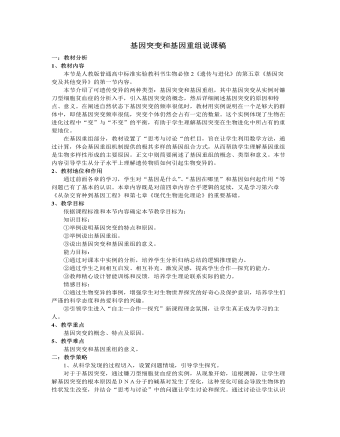
人教版高中生物必修2基因突变和基因重组说课稿
1、教材内容本节是人教版普通高中标准实验教科书生物必修2《遗传与进化》的第五章《基因突变及其他变异》的第一节内容。本节介绍了可遗传变异的两种类型:基因突变和基因重组,其中基因突变从实例对镰刀型细胞贫血症的分析入手,引入基因突变的概念,然后详细阐述基因突变的原因和特点、意义。在阐述自然状态下基因突变的频率很低时,教材用实例说明在一个足够大的群体中,即使基因突变频率很低,突变个体仍然会占有一定的数量。这个实例体现了生物在进化过程中“变”与“不变”的平衡,有助于学生理解基因突变在生物进化中所占有的重要地位。在基因重组部分,教材设置了“思考与讨论“的栏目,旨在让学生利用数学方法,通过计算,体会基因重组机制提供的极其多样的基因组合方式,从而帮助学生理解基因重组是生物多样性形成的主要原因。正文中则简要阐述了基因重组的概念、类型和意义。本节内容引导学生从分子水平上理解遗传物质如何引起生物变异的。
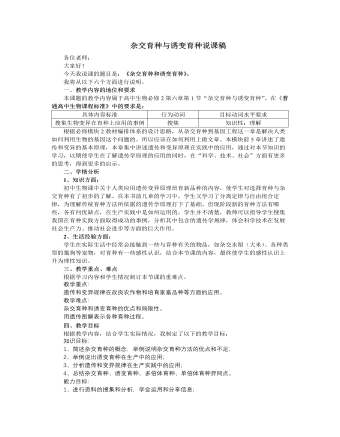
人教版高中生物必修2杂交育种与诱变育种说课稿
二、诱变育种1、创设情境,引出课题 出示教具或图片:一穗具有黄粒性状的玉米。问题:怎样利用现有的玉米品种培育出具有黑色性状的玉米新品种呢?2、阅读资料、讨论研究 课前布置兴趣小组同学搜集有关航天诱变育种的资料,并在此基础上进行整理。这样可以培养学生搜集并且整理资料的能力,并体会科学技术与人们生产生活的密切联系。 学生阅读生物兴趣小组课前搜集的有关航天诱变育种问题的资料及教材P100得内容。以小组为单位讨论回答有关诱变育种的有关问题,附:设置的问题:1、 新品种中有没有产生新基因?2、空中诱发基因突变的条件有哪些?3、航天诱变育种有哪些优点?4、地面上有哪些因素可以诱发生物体产生基因突变?5、诱变育种有哪些局限性?如何克服?以航天诱变育种为典型,解决诱变育种过程中遇到的相关问题。让学生学会对已有知识进行应用。3、归纳总结,形成体系 通过以小组为单位的表达和交流,师生共同总结归纳,形成有关诱变育种的知识体系,提升学生对于知识的理解。
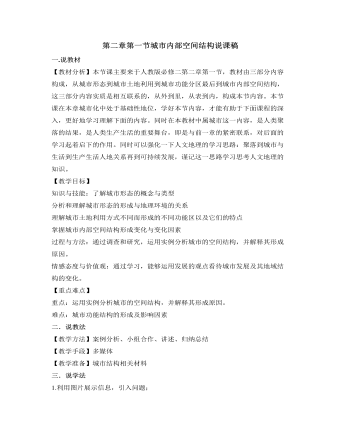
人教版高中地理必修2第二章第一节城市内部空间结构说课稿
提问:结合课本找出城市地域结构模式的类型及各自特点,模式形成的因素又有哪些?学生回答,使其掌握基本模式及特点,通过对比,分析把握每一模式各自的特征,学会把握事物本质。◆设计意图:阅读课本,总结归纳,同时引导,通过原因规律的探究,大胆设想,总结规律掌握人文地理学习思路。4.活动设计:内部空间结构变化,结合实例,分析说明。提问:结合江宁区的变化,分析江宁区城市结构发生了哪些变化?结合课本24页活动题,提出功能结构布局方案?通过理论联系实际,让学生更好理解理论,掌握城市结构布局的变化及其影响因素,通过活动题方案的提出,学生能够掌握布局的规律性,解决问题。设计意图:理论联系实际,知识的不枯燥性,提高学生学习兴趣。同时,能够通过总结,深层次认识城市结构布局,活学活用。
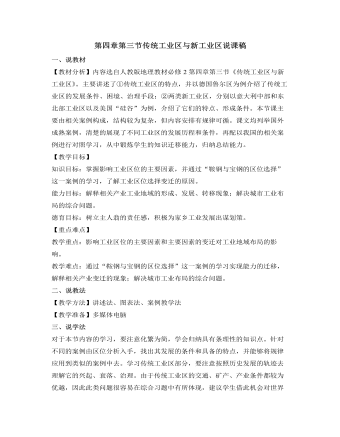
人教版高中地理必修2第四章第三节传统工业区与新工业区说课稿
下面是对以高技术产业为主的新工业区的内容进行讲解,教材以美国“硅谷”为例,首先谈的是高技术工业的特点,然后讲述的是“硅谷”的发展条件,由于教学模式与意大利新工业区的内容基本一致,这里就不再赘述了。接下来教材中提到的与之对照的案例同样是以高技术产业而闻名的中关村,由于中关村在国内的知名度较高,一般学生都有所了解,因此不妨让学生谈谈自己的看法:对于高新技术产业的发展有何建议,相对于发展较为成功的“硅谷”我们需要学习的方面又是哪些?案例中最后一个问题很值得深省,我国的新工业区到底怎样做才能够获得成功,简单的模仿下我们缺少的又是什么?这个问题可以作为拓展,让学生写一篇简短的论文作为课后作业。最后做以简单的课堂小结。本节内容的教学可能会相对繁杂,而案例之间的分析过程又过于雷同,所以难免枯燥。在处理这个问题上,我将尽量做到详略得当,主要培养学生的自主学习能力。
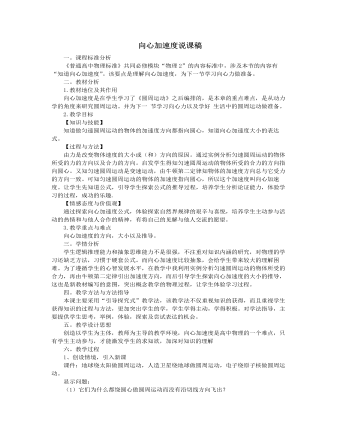
人教版新课标高中物理必修2向心加速度说课稿
d.某物体沿直线向东运动,原来的速度是5m/s,2s后速度减小到3m/s,求2s内物体速度变化。④如何探究物体作匀速圆周运动时,在Δt时间内的速度变化?分析:有了同一直线上速度变化的铺垫后,讨论物体做匀速圆周运动速度的变化就比较自然了,为了给向心加速度方向的学习打好基础,可以通过小组协作,进一步完成下列思考题,使同学们认识到:时间间隔起短,速度变化的方向起接近半径方向。(多媒体屏幕投影)a.物体沿半径为1m的轨道做匀速圆周运动,线速度大小为,求1s内物体速度变化并画出1s内速度变化的示意图。b.分别求出上题中物体在0.5s、0.25s内速度变化并画出相应的示意图。由于没有办法直接利用实验来验证速度变化的方向,所以,我们采用提供思考题的方法,引导同学在合作学习、自主探究中完成。有了速度变化的研究为铺垫,加速度的方向问题就迎刃而解了。
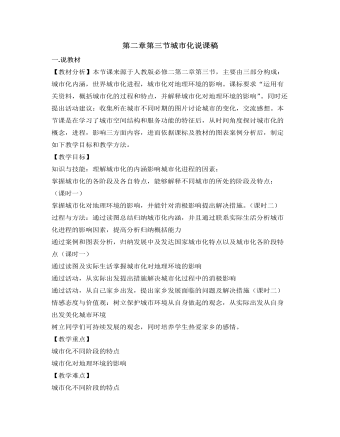
人教版高中地理必修2第二章第三节城市化说课稿
投影上海市的卫星城镇建设、交通改善图以及住房图等,探讨上海为解决城市化的问题做了哪些方面的工作?进一步引导思考总结对于城市化带来的问题,除了上海市的做法,你还有什么想法?◆设计意图:借上海的例子一方面引导学生解决问题的思路,让学生自己掌握城市化问题及措施,活跃思维;另一方面帮助学生树立学习优秀的意识;4.活动设计.未来展望——生态城市课本38页的活动,结合合肥市环城公园,解释生态城市。◆设计意图:进一步让学生认识到人地协调的重要性,牢固树立可持续发展的观念。5.活动设计分析南京的城市化过程中存在哪些问题,除了共性外,还有没有自己的个性问题?对于问题展开讨论,并提出相应的解决措施。◆设计意图:结合身边的地理,落实乡土地理的教育,激发学生热爱家乡,从身边的环境小事做起,落实环境教育。
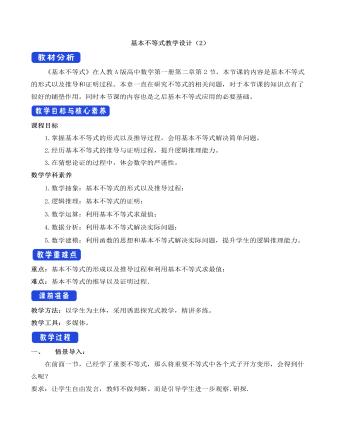
人教A版高中数学必修一基本不等式教学设计(2)
《基本不等式》在人教A版高中数学第一册第二章第2节,本节课的内容是基本不等式的形式以及推导和证明过程。本章一直在研究不等式的相关问题,对于本节课的知识点有了很好的铺垫作用。同时本节课的内容也是之后基本不等式应用的必要基础。课程目标1.掌握基本不等式的形式以及推导过程,会用基本不等式解决简单问题。2.经历基本不等式的推导与证明过程,提升逻辑推理能力。3.在猜想论证的过程中,体会数学的严谨性。数学学科素养1.数学抽象:基本不等式的形式以及推导过程;2.逻辑推理:基本不等式的证明;3.数学运算:利用基本不等式求最值;4.数据分析:利用基本不等式解决实际问题;5.数学建模:利用函数的思想和基本不等式解决实际问题,提升学生的逻辑推理能力。重点:基本不等式的形成以及推导过程和利用基本不等式求最值;难点:基本不等式的推导以及证明过程.
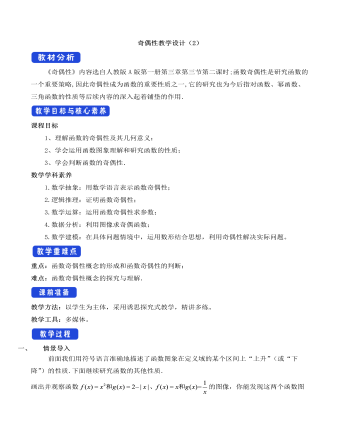
人教A版高中数学必修一奇偶性教学设计(2)
《奇偶性》内容选自人教版A版第一册第三章第三节第二课时;函数奇偶性是研究函数的一个重要策略,因此奇偶性成为函数的重要性质之一,它的研究也为今后指对函数、幂函数、三角函数的性质等后续内容的深入起着铺垫的作用.课程目标1、理解函数的奇偶性及其几何意义;2、学会运用函数图象理解和研究函数的性质;3、学会判断函数的奇偶性.数学学科素养1.数学抽象:用数学语言表示函数奇偶性;2.逻辑推理:证明函数奇偶性;3.数学运算:运用函数奇偶性求参数;4.数据分析:利用图像求奇偶函数;5.数学建模:在具体问题情境中,运用数形结合思想,利用奇偶性解决实际问题。重点:函数奇偶性概念的形成和函数奇偶性的判断;难点:函数奇偶性概念的探究与理解.教学方法:以学生为主体,采用诱思探究式教学,精讲多练。
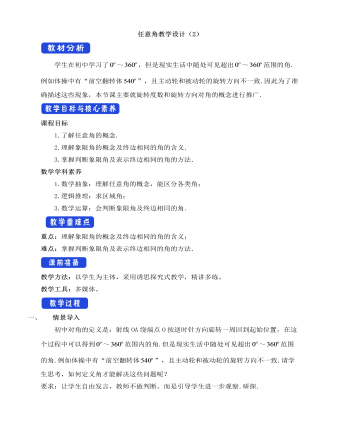
人教A版高中数学必修一任意角教学设计(2)
学生在初中学习了 ~ ,但是现实生活中随处可见超出 ~ 范围的角.例如体操中有“前空翻转体 ”,且主动轮和被动轮的旋转方向不一致.因此为了准确描述这些现象,本节课主要就旋转度数和旋转方向对角的概念进行推广.课程目标1.了解任意角的概念.2.理解象限角的概念及终边相同的角的含义.3.掌握判断象限角及表示终边相同的角的方法.数学学科素养1.数学抽象:理解任意角的概念,能区分各类角;2.逻辑推理:求区域角;3.数学运算:会判断象限角及终边相同的角.重点:理解象限角的概念及终边相同的角的含义;难点:掌握判断象限角及表示终边相同的角的方法.教学方法:以学生为主体,采用诱思探究式教学,精讲多练。教学工具:多媒体。一、 情景导入初中对角的定义是:射线OA绕端点O按逆时针方向旋转一周回到起始位置,在这个过程中可以得到 ~ 范围内的角.但是现实生活中随处可见超出 ~ 范围的角.例如体操中有“前空翻转体 ”,且主动轮和被动轮的旋转方向不一致.
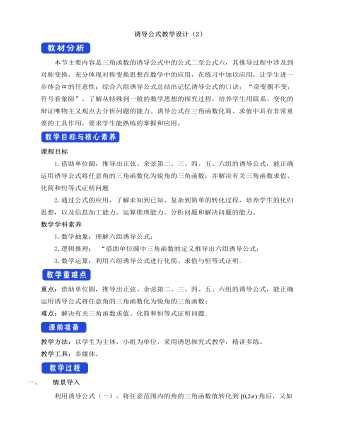
人教A版高中数学必修一诱导公式教学设计(2)
本节主要内容是三角函数的诱导公式中的公式二至公式六,其推导过程中涉及到对称变换,充分体现对称变换思想在数学中的应用,在练习中加以应用,让学生进一步体会 的任意性;综合六组诱导公式总结出记忆诱导公式的口诀:“奇变偶不变,符号看象限”,了解从特殊到一般的数学思想的探究过程,培养学生用联系、变化的辩证唯物主义观点去分析问题的能力。诱导公式在三角函数化简、求值中具有非常重要的工具作用,要求学生能熟练的掌握和应用。课程目标1.借助单位圆,推导出正弦、余弦第二、三、四、五、六组的诱导公式,能正确运用诱导公式将任意角的三角函数化为锐角的三角函数,并解决有关三角函数求值、化简和恒等式证明问题2.通过公式的应用,了解未知到已知、复杂到简单的转化过程,培养学生的化归思想,以及信息加工能力、运算推理能力、分析问题和解决问题的能力。





















